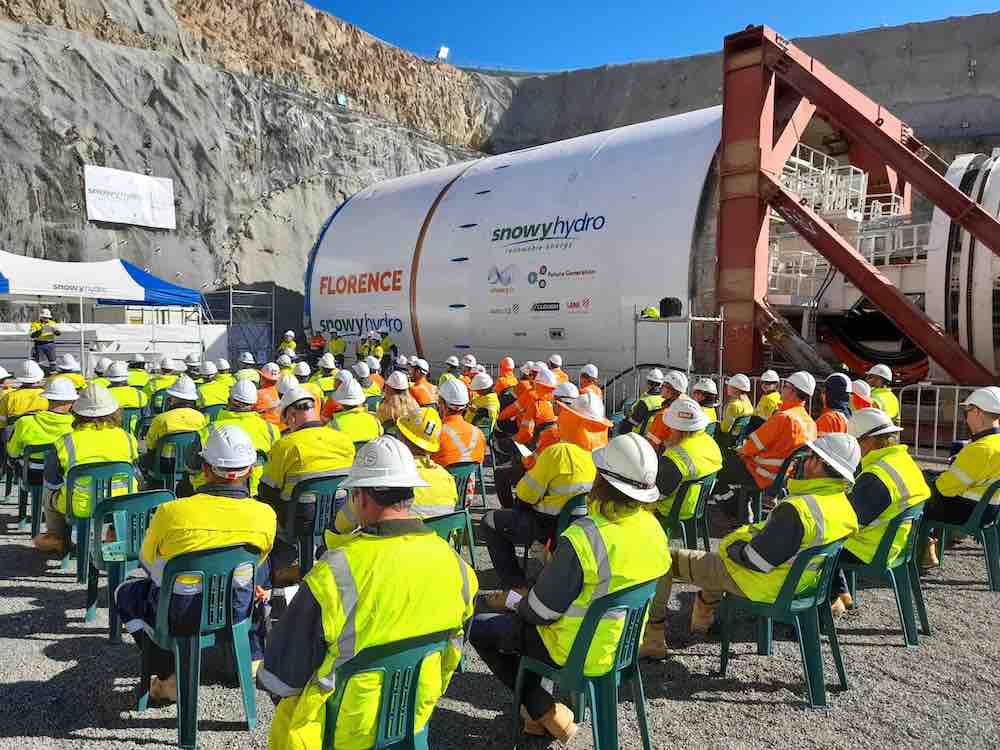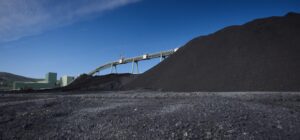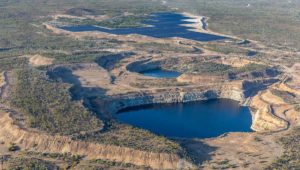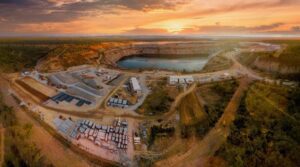Planning documents seeking approval to fix the Snowy 2.0 sinkhole and un-pause the boring machine named Florence, warn there could be more of the same problems ahead for the massive project whose budget has now blown out to $12 billion.
The planning application and series of supporting documents from Snowy Hydro, published this week on the NSW government portal, seek permission for “remediation of sinkhole and ground consolidation works to facilitate the progression of TBM Florence.”
Snowy needs to do this because the nine-metre deep sinkhole caused by tunnelling in unexpectedly soft ground is outside of the project’s construction zone. The voluminous planning documents, including a 383-page geotechnical report, will be open to public submissions for just two weeks.
The application comes just days after the federal energy minister Chris Bowen confirmed that the bill for construction of the 2.2GW Snowy 2.0 pumped hydro project has ballooned to a massive $12 billion – double previous estimates.
Bowen is yet to publicly release the full report detailing the cost blowout, including the $4.3 billion already spent, but said last week that “design immaturity” at the time of final investment decision and site conditions and geology that “should have been known” were key contributing factors.
Some detail can be found in the application documents, however, including statements that contradict previous advice on the project’s progress from Snowy Hydro, and frank admissions that more sinkholes and stranded boring machines could lie ahead.
“The original geological predictions anticipated in the geotechnical baseline report for the Tantangara Headrace Adit Tunnel, indicated a different geological condition than those encountered by the TBM where the sinkhole was formed,” the voluminous geotechnical report says.
“Additional faults and poor ground conditions cannot be ruled out in future TBM excavation activities along the tunnel alignments.
“Areas with potential poor ground conditions may also include Tantangara Headrace Tunnel (HRT01), Tantangara Headrace Tunnel (HRT01-02), Gate Shaft and Tantangara Intake.”
The Tantangara Headrace Tunnel, for those playing at home, is where Florence is headed – or where she was supposed to be headed at a rate of 30 metres per day over a distance of 17km.
The report notes that in around May 2022, the TBM (tunnel boring machine) “began encountering adverse geological conditions unsuitable for tunnelling” according to the machine’s settings at the time.
It goes on to say that Florence got properly stuck in December when she entered into “a fault zone and encountered sandy material with no apparent cohesion.” At this stage, only 146 metres of tunnelling progress had been made, the report says.
“On stalling the cutterhead rotation the sandy material entered the muck chamber of the TBM in an uncontrolled
manner, forming an inferred chimney structure above the tunnelling excavations,” the report says.
“The available mitigation measure installed on the TBM at the time of the event were not able to treat the unexpected sandy material.
“The inferred chimney structure created a surface depression (sinkhole) outside the approved construction envelope and disturbance boundary.
“Upon formation of the sinkhole, TBM operations were suspended. Due to the formation of the sinkhole, remediation works are required, further geotechnical investigations are ongoing, and tunnelling operations may be modified.”
This account is a long way from the chipper updated Snowy Hydro offered in May – at the same time Florence was first getting into bother – when it said “highly variable” ground conditions were “as anticipated… ranging from soft, sandy ground to extremely hard rock.”
“Snowy Hydro expects variable and soft ground conditions to occur in sections of the very long 17-kilometre headrace tunnel,” the update said.
“TBM Florence has been specifically designed to encounter these variable ground conditions.”
This, too, is contradicted in the geotechnical report, which says that the current configuration of Florence “can be subject to challenges when facing unconsolidated ground conditions.” She can, however, “be modified to slurry mode to change the excavation methodology, depending on the geological conditions.”
In December, which we now know was when tunnelling was stopped, another update assured that the “surface depression” had not compromised the integrity of the tunnel, and “tunnelling is continuing while work to remediate the surface depression above tunnel boring machine (TBM) Florence is carried out.”
Rather, according to the geotechnical report, “the last tunneling excavation advance in December 2022” was halted after just 1.5m, after “the quantity of material entering the cutter head significantly increased.
“Due to this increased quantity of spoil entering the excavation chamber at Tunnel Length 145.8 m the excavation was stopped due to ground loss resulting in the sinkhole formation.”










